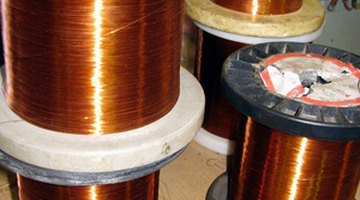How to Make Fish Tape With Tools
Wiring a house without some means of dragging wire into place where it belongs is nearly impossible. The right tool for the job is a fish tape. A fish tape is a thin, flexible steel tape, typically 1/4 to 1/2-inch wide, that comes on a large reel, similar to a surveyor's tape measure.

Much of the wiring in new construction can be done without it, since the interior of walls and ceilings is still accessible. Without a machine shop, making your own fish tape is very difficult. If you have more than a fixture or two to rewire, a fish tape is well worth the investment. There are a few alternatives with common tools that will work in a pinch.
Things You Will Need
- Tape measure
- Sewer snake
- Fishing pole
- Wire
- Wire cutters
- Electrical tape
- PVC pipe
- Drill
Fish Tape Substitutes
-
Use a thin-bladed tape measure to run through the path where the wire will be installed. Flatten the end of the tape with a hammer to help it slip through. Tie the new wire onto the end of the tape measure and release the lock down to allow the spring to reel in the tape, dragging the wire behind it. Use a tape that you don't mind bending a little, and don't count on more than one or two pulls.
-
Remove the Coil from the end of a flat plumbing snake. Remove the set screw with a phillips screwdriver or allen wrench, depending on the snake. Feed the ribbon of the snake through the wall or ceiling to where the wire pull will begin. Tape the wire to the snake securely with a piece of duct tape and reel the snake back in.
-
Break the eyelets from an old fishing pole to make a fish stick for short, straight runs. Bend the eyes with pliers until the wire breaks. Leave the last eyehook and bend it gently until it stands straight out from the end. Tie wire to this eye and pull the rod out to drag the wire through.
Making a Fish Tape
-
Choose the heaviest, single strand wire available, 60 to 8 gauge works well. You want a wire that will bend without kinking easily. Measure the longest run you will be pulling and cut the wire about 3-feet longer than that with wire cutters.
-
Bend the last 3-inches of the tape into a smooth noose, folding the wire back onto itself and wrapping the wire around itself. Wrap electrical tape around the wire wrapping to prevent it snagging. This is your lead end.
-
Cut a 12-inch piece of 3-inch thick PVC pipe and drill a 1/4-inch hole through both sides of the pipe, feed the end of the wire opposite the lead through the pipe and wrap it around the PVC twice, twisting the wire onto itself to fasten it in place. Wrap the wire wrapping with electrical tape to prevent cutting yourself on sharp wire ends.
-
Feed your makeshift fish tape into the wall or ceiling along the desired course for the wire. Cut a second wire and bend a hook in its end to help guide your fish wire out the other end if needed. Tie the wire to the noose and extract the fish tape to pull the wire into place. Pull the wire back out by wrapping it onto the PVC for stubborn pulls.
The Drip Cap
- Wiring a house without some means of dragging wire into place where it belongs is nearly impossible.
- A fish tape is a thin, flexible steel tape, typically 1/4 to 1/2-inch wide, that comes on a large reel, similar to a surveyor's tape measure.
- Without a machine shop, making your own fish tape is very difficult.
- Feed the ribbon of the snake through the wall or ceiling to where the wire pull will begin.
- Measure the longest run you will be pulling and cut the wire about 3-feet longer than that with wire cutters.
- Wrap electrical tape around the wire wrapping to prevent it snagging.
- Tie the wire to the noose and extract the fish tape to pull the wire into place.
References
- Hometips: Electrical Wiring Tips
- “Advanced Home Wiring:”; Creative Publishing International; 2009
Writer Bio
Mark Morris started writing professionally in 1995. He has published a novel and stage plays with SEEDS studio. Morris specializes in many topics and has 15 years of professional carpentry experience. He is a voice, acting and film teacher. He also teaches stage craft and lectures on playwriting for Oklahoma Christian University.
Photo Credits
- spools with a wire image by Victor M. from Fotolia.com
- spools with a wire image by Victor M. from Fotolia.com
More Articles



